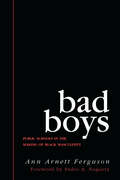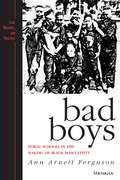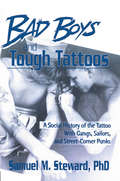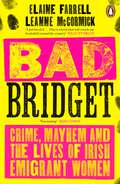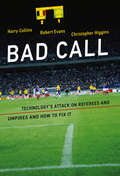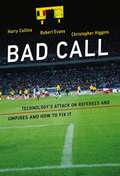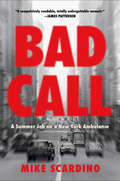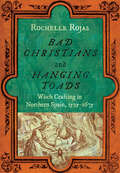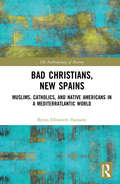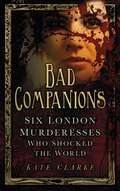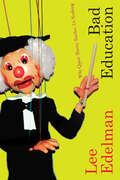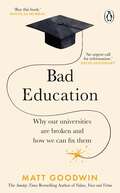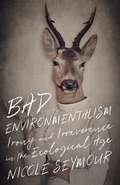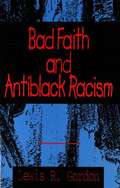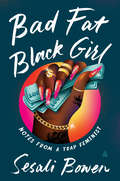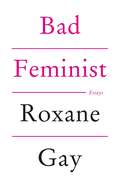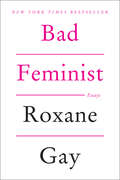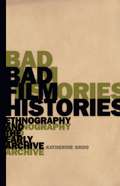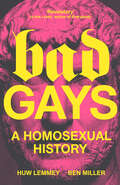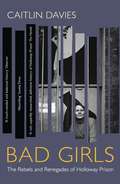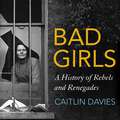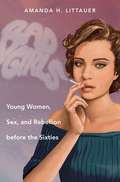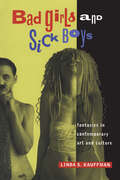- Table View
- List View
Bad Boys: Public Schools in the Making of Black Masculinity (Law, Meaning, And Violence)
by Ann Arnett FergusonBlack males are disproportionately "in trouble" and suspended from the nation’s school systems. This is as true now as it was when Ann Arnett Ferguson’s now classic Bad Boys was first published. Bad Boys offers a richly textured account of daily interactions between teachers and students in order to demonstrate how a group of eleven- and twelve-year-old males construct a sense of self under adverse circumstances. This new edition includes a foreword by Pedro A. Noguera, and an afterword and bibliographic essay by the author, all of which reflect on the continuing relevance of this work nearly two decades after its initial publication.
Bad Boys: Public Schools in the Making of Black Masculinity
by Arnett Ferguson<P>Statistics show that black males are disproportionately getting in trouble and being suspended from the nation's school systems. Based on three years of participant observation research at an elementary school, Bad Boys offers a richly textured account of daily interactions between teachers and students to understand this serious problem. <P>Ann Arnett Ferguson demonstrates how a group of eleven- and twelve-year-old males are identified by school personnel as "bound for jail" and how the youth construct a sense of self under such adverse circumstances. The author focuses on the perspective and voices of pre-adolescent African American boys. How does it feel to be labeled "unsalvageable" by your teacher? How does one endure school when the educators predict one's future as "a jail cell with your name on it?" <P>Through interviews and participation with these youth in classrooms, playgrounds, movie theaters, and video arcades, the author explores what "getting into trouble" means for the boys themselves. She argues that rather than simply internalizing these labels, the boys look critically at schooling as they dispute and evaluate the meaning and motivation behind the labels that have been attached to them. Supplementing the perspectives of the boys with interviews with teachers, principals, truant officers, and relatives of the students, the author constructs a disturbing picture of how educators' beliefs in a "natural difference" of black children and the "criminal inclination" of black males shapes decisions that disproportionately single out black males as being "at risk" for failure and punishment. <P>Bad Boys is a powerful challenge to prevailing views on the problem of black males in our schools today. It will be of interest to educators, parents, and youth, and to all professionals and students in the fields of African-American studies, childhood studies, gender studies, juvenile studies, social work, and sociology, as well as anyone who is concerned about the way our schools are shaping the next generation of African American boys.
Bad Boys and Tough Tattoos: A Social History of the Tattoo With Gangs, Sailors, and Street-Corner Punks 1950-1965
by Samuel M. Steward, PhDExplore the dark subculture of 1950s tattoos!In the early 1950s, when tattoos were the indelible mark of a lowlife, an erudite professor of English--a friend of Gertrude Stein, Thomas Mann, Andre Gide, and Thornton Wilder--abandoned his job to become a tattoo artist (and incidentally a researcher for Alfred Kinsey). Bad Boys and Tough Tattoos tells the story of his years working in a squalid arcade on Chicago’s tough State Street. During that time he left his mark on a hundred thousand people, from youthful sailors who flaunted their tattoos as a rite of manhood to executives who had to hide their passion for well-ornamented flesh. Bad Boys and Tough Tattoos is anything but politically correct. The gritty, film-noir details of Skid Row life are rendered with unflinching honesty and furtive tenderness. His lascivious relish for the young sailors swaggering or staggering in for a new tattoo does not blind him to the sordidness of the world they inhabited. From studly nineteen-year-olds who traded blow jobs for tattoos to hard-bitten dykes who scared the sailors out of the shop, the clientele was seedy at best: sailors, con men, drunks, hustlers, and Hells Angels. These days, when tattoo art is sported by millionaires and the middle class as well as by gang members and punk rockers, the sheer squalor of Bad Boys and Tough Tattoos is a revelation. However much tattoo culture has changed, the advice and information is still sound: how to select a good tattoo artist what to expect during a tattooing session how to ensure the artist uses sterile needles and other safety precautions how to care for a new tattoo why people get tattoos--25 sexual motivations for body artMore than a history of the art or a roster of famous--and infamous--tattoo customers and artists, Bad Boys and Tough Tattoos is a raunchy, provocative look at a forgotten subculture.
Bad Boys and Tough Tattoos: A Social History of the Tattoo With Gangs, Sailors, and Street-Corner Punks 1950-1965
by Samuel M. Steward, PhDExplore the dark subculture of 1950s tattoos!In the early 1950s, when tattoos were the indelible mark of a lowlife, an erudite professor of English--a friend of Gertrude Stein, Thomas Mann, Andre Gide, and Thornton Wilder--abandoned his job to become a tattoo artist (and incidentally a researcher for Alfred Kinsey). Bad Boys and Tough Tattoos tells the story of his years working in a squalid arcade on Chicago’s tough State Street. During that time he left his mark on a hundred thousand people, from youthful sailors who flaunted their tattoos as a rite of manhood to executives who had to hide their passion for well-ornamented flesh. Bad Boys and Tough Tattoos is anything but politically correct. The gritty, film-noir details of Skid Row life are rendered with unflinching honesty and furtive tenderness. His lascivious relish for the young sailors swaggering or staggering in for a new tattoo does not blind him to the sordidness of the world they inhabited. From studly nineteen-year-olds who traded blow jobs for tattoos to hard-bitten dykes who scared the sailors out of the shop, the clientele was seedy at best: sailors, con men, drunks, hustlers, and Hells Angels. These days, when tattoo art is sported by millionaires and the middle class as well as by gang members and punk rockers, the sheer squalor of Bad Boys and Tough Tattoos is a revelation. However much tattoo culture has changed, the advice and information is still sound: how to select a good tattoo artist what to expect during a tattooing session how to ensure the artist uses sterile needles and other safety precautions how to care for a new tattoo why people get tattoos--25 sexual motivations for body artMore than a history of the art or a roster of famous--and infamous--tattoo customers and artists, Bad Boys and Tough Tattoos is a raunchy, provocative look at a forgotten subculture.
Bad Bridget: Crime, Mayhem and the Lives of Irish Emigrant Women
by Elaine Farrell Leanne McCormickThe Number 1 Bestseller'A captivating account of lives previously ignored' Sunday Independent'An important, impeccably researched though eminently readable book that charts new territory' Irish Examiner* * *Ireland in the nineteenth and early twentieth centuries was not a good place to be a woman. Among the wave of emigrants from Ireland to North America were many, many young women who travelled on their own, hoping for a better life. Some lived lives of quiet industry and piety. Others quickly found themselves in trouble - bad trouble, and on an astonishing scale.Elaine Farrell and Leanne McCormick, creators of the celebrated 'Bad Bridget' podcast, have unearthed a world in which Irish women actually outnumbered Irish men in prison, in which you could get locked up for 'stubbornness', and in which a serial killer called Lizzie Halliday was described by the New York Times as 'the worst woman on earth'. They reveal the social forces that bred this mayhem and dysfunction, through stories that are brilliantly strange, sometimes funny, and often moving. From sex workers and thieves to kidnappers and killers, these Bridgets are young women who have gone from the frying pan of their impoverished homeland to the fire of vast North American cities.Bad Bridget is a masterpiece of social history and true crime, showing us a fascinating and previously unexplored world.* * * 'I just loved it!' Ryan Tubridy'Fascinating' Irish Times'Rich in detail and thorough in research' New Statesman
Bad Call: Technology's Attack on Referees and Umpires and How to Fix It (Inside Technology)
by Harry Collins Robert Evans Christopher HigginsHow technologies can get it wrong in sports, and what the consequences are—referees undermined, fans heartbroken, and the illusion of perfect accuracy maintained.Good call or bad call, referees and umpires have always had the final say in sports. Bad calls are more visible: plays are televised backward and forward and in slow motion. New technologies—the Hawk-Eye system used in tennis and cricket, for example, and the goal-line technology used in English football—introduced to correct bad calls sometimes get it right and sometimes get it wrong, but always undermine the authority of referees and umpires. Bad Call looks at the technologies used to make refereeing decisions in sports, analyzes them in action, and explains the consequences.Used well, technologies can help referees reach the right decision and deliver justice for fans: a fair match in which the best team wins. Used poorly, however, decision-making technologies pass off statements of probability as perfect accuracy and perpetuate a mythology of infallibility. The authors re-analyze three seasons of play in English Premier League football, and discover that goal line technology was irrelevant; so many crucial wrong decisions were made that different teams should have won the Premiership, advanced to the Champions League, and been relegated. Simple video replay could have prevented most of these bad calls. (Major League baseball learned this lesson, introducing expanded replay after a bad call cost Detroit Tigers pitcher Armando Galarraga a perfect game.)What matters in sports is not computer-generated projections of ball position but what is seen by the human eye—reconciling what the sports fan sees and what the game official sees.
Bad Call: Technology's Attack on Referees and Umpires and How to Fix It
by Harry Collins Christopher Higgins Robert EvansGood call or bad call, referees and umpires have always had the final say in sports. Bad calls are more visible: plays are televised backward and forward and in slow motion. New technologies -- the Hawk-Eye system used in tennis and cricket, for example, and the goal-line technology used in English football -- introduced to correct bad calls sometimes get it right and sometimes get it wrong, but always undermine the authority of referees and umpires. Bad Call looks at the technologies used to make refereeing decisions in sports, analyzes them in action, and explains the consequences.Used well, technologies can help referees reach the right decision and deliver justice for fans: a fair match in which the best team wins. Used poorly, however, decision-making technologies pass off statements of probability as perfect accuracy and perpetuate a mythology of infallibility. The authors re-analyze three seasons of play in English Premier League football, and discover that goal line technology was irrelevant; so many crucial wrong decisions were made that different teams should have won the Premiership, advanced to the Champions League, and been relegated. Simple video replay could have prevented most of these bad calls. (Major League baseball learned this lesson, introducing expanded replay after a bad call cost Detroit Tigers pitcher Armando Galarraga a perfect game.)What matters in sports is not computer-generated projections of ball position but what is seen by the human eye -- reconciling what the sports fan sees and what the game official sees.
Bad Call: A Summer Job on a New York Ambulance
by Mike ScardinoAn adrenaline-fueled read that will stay with you long after the you turn the final page, BAD CALL is a "compulsively readable, totally unforgettable"* memoir about working on a New York City ambulance in the 1960s. (*James Patterson)Bad Call is Mike Scardino's visceral, fast-moving, and mordantly funny account of the summers he spent working as an "ambulance attendant" on the mean streets of late-1960s New York. Fueled by adrenaline and Sabrett's hot dogs, young Mike spends his days speeding from one chaotic emergency to another. His adventures take him into the middle of incipient race riots, to the scene of a plane crash at JFK airport and into private lives all over Queens, where New Yorkers are suffering, and dying, in unimaginable ways. Learning on the job, Mike encounters all manner of freakish accidents (the man who drank Drano, the woman attacked by rats, the man who inflated like a balloon), meets countless unforgettable New York characters, falls in love, is nearly murdered, and gets an early and indelible education in the impermanence of life and the cruelty of chance. Action-packed, poignant, and rich with details that bring Mike's world to technicolor life, Bad Call is a gritty portrait of a bygone era as well as a bracing reminder that, though "life itself is a fatal condition," it's worth pausing to notice the moments of beauty, hope, and everyday heroism along the way.
Bad Christians and Hanging Toads: Witch Crafting in Northern Spain, 1525–1675
by Rochelle RojasBad Christians and Hanging Toads tells riveting stories of witchcraft in everyday life in early modern Navarra. Belief in witchcraft not only emerged in moments of mass panic but was woven into the fabric of village life. Some villagers believed witches sickened crops and cows with poisonous powders, others thought they engaged in diabolism and perverted sex, and still others believed they lovingly raised toads used to commit evil deeds. Most villagers, however, simply saw witches as those with reputations of being mala cristianas—bad Christians. Rochelle Rojas illuminates the social webs of accusations and the pathways of village gossip that created the conditions for the witch beliefs and trials of the period.While studies of witchcraft in Spain tend to focus on the inquisitorial trials and witch panic of 1609–14, Bad Christians and Hanging Toads turns to witch trials conducted by the region's secular judiciary, Navarra's royal tribunals, tracing the prosecution of accused witches over 150 years. Using detailed evidence from trial records and neighbors' testimonies, Rojas vividly brings to life the women and men crafted as witches by their neighbors and the authorities and guides readers through the judicial process, from accusations and the examination of the evidence to sentencing and punishment.By privileging the voices of villagers throughout, Bad Christians and Hanging Toads demonstrates that the inner logic of early modern European witchcraft trials can be understood only by examining of the local, everyday aspects of witch belief.
Bad Christians, New Spains: Muslims, Catholics, and Native Americans in a Mediterratlantic World (The Anthropology of History)
by Byron E. HamannThis book centers on two inquisitorial investigations, both of which began in the 1540s. One involved the relations of Europeans and Native Americans in an Oaxacan town (in New Spain, today’s Mexico). The other involved relations of Moriscos (recent Muslim converts to Catholicism) and Old Christians (people with deep Catholic ancestries) in the Mediterranean kingdom of Valencia (in the "old" Spain). Although separated by an ocean, the social worlds preserved in the inquisitorial files share many things. By comparing and contrasting the two inquisitions, Hamann reveals how very local practices and debates had long-distance parallels that reveal the larger entanglements of a transatlantic early modern world. Through a dialogue of two microhistories, he presents a macrohistory of large-scale social transformation. We see how attempts in both places to turn old worlds into new ones were centered on struggles over materiality and temporality. By paying close attention to theories (and practices) of reduction and conversion, Hamann suggests we can move beyond anachronistic models of social change as colonization and place questions of time and history at the center of our understandings of the sixteenth-century past. The book is an intervention in major debates in both history and anthropology: about the writing of global histories, our conceptualizations of the colonial, the nature of religious and cultural change, and the roles of material things in social life and the imagination of time.
Bad Companions: Six London Murderesses Who Shocked the World
by Kate ClarkeThis book features the cases of six London women, each very different in temperament, age and status, who resorted to murder. Their reasons were varied: in the case of the surly maid Kate Webster, sheer temper seems the likely cause; avarice seemed to spur Catherine Wilson to murder an estimated seven times; desperation to pay for the upkeep of her two-year-old son lay behind Sarah Drake’s crime; seductive young cook Eliza Fenning was accused of serving poison with her dumplings; evil mistress Elizabeth Brownrigg whipped her servant to death in a home-built dungeon; and finally, the vicious Catherine Hayes persuaded two lovers – one of whom was her own son – to decapitate her husband in an orgy of violence. This fascinating study explores these cases in depth, and reveals whether these women were tragic, misunderstood or just plain wicked.
Bad Education: Why Queer Theory Teaches Us Nothing (Theory Q)
by Lee EdelmanLong awaited after No Future, and making queer theory controversial again, Lee Edelman’s Bad Education proposes a queerness without positive identity—a queerness understood as a figural name for the void, itself unnamable, around which the social order takes shape. Like Blackness, woman, incest, and sex, queerness, as Edelman explains it, designates the antagonism, the structuring negativity, preventing that order from achieving coherence. But when certain types of persons get read as literalizing queerness, the negation of their negativity can seem to resolve the social antagonism and totalize community. By translating the nothing of queerness into the something of “the queer,” the order of meaning defends against the senselessness that undoes it, thus mirroring, Edelman argues, education’s response to queerness: its sublimation of irony into the meaningfulness of a world. Putting queerness in relation to Lacan’s “ab-sens” and in dialogue with feminist and Afropessimist thought, Edelman reads works by Shakespeare, Jacobs, Almodóvar, Lemmons, and Haneke, among others, to show why queer theory’s engagement with queerness necessarily results in a bad education that is destined to teach us nothing.
Bad Education: Why Our Universities Are Broken and How We Can Fix Them
by Matt Goodwin'Buy this book' DOUGLAS MURRAY'An urgent call for reformation’ DAVID GOODHARTTHE EXPLOSIVE NEW BOOK FROM THE SUNDAY TIMES BESTSELLING AUTHOR OF NATIONAL POPULISM AND VALUES, VOICE AND VIRTUE.Depressed tutors and disillusioned students. Funding crises and falling standards. Culture wars and campus protests. Welcome to the broken world of academia. Welcome to Bad Education.-------------------------Our universities are broken. Established as sanctuaries of truth and higher learning, they are now decaying institutions that are failing a generation of young people. Consumed by funding and admissions crises, mired in political scandal and governed by self-interest, their founding principles have been corrupted. This explosive book shows us why, and what we must do to fix them.Matt Goodwin spent decades working as an academic in some of the world’s leading universities, delivering underfunded courses to increasingly disengaged lecture theatres, sitting on rudderless committees, counselling depressed colleagues and concerned students, watching standards slip and academic integrity decline.At the heart of this crisis is an increasingly politicised campus. Once bastions of free speech, forums for open debate and incubators of bold new ideas, our universities are increasingly becoming monocultures, ruled by an ideology that is silencing respected voices, stifling discussion and violently shutting down diverse opinion, betraying intellectual freedom and failing to deliver the very basics of an education.Unflinching, shocking and urgent, this first-hand account provides an insider's view of how the founding principles of academia are in decline and why we should all consider what this means for the students of today, tomorrow and the world they will shape.
Bad Environmentalism: Irony and Irreverence in the Ecological Age
by Nicole SeymourTraces a tradition of ironic and irreverent environmentalism, asking us to rethink the movement&’s reputation for gloom and doomActivists today strive to educate the public about climate change, but sociologists have found that the more we know about alarming issues, the less likely we are to act. Meanwhile, environmentalists have acquired a reputation as gloom-and-doom killjoys. Bad Environmentalism identifies contemporary texts that respond to these absurdities and ironies through absurdity and irony—as well as camp, frivolity, irreverence, perversity, and playfulness. Nicole Seymour develops the concept of &“bad environmentalism&”: cultural thought that employs dissident affects and sensibilities to reflect critically on our current moment and on mainstream environmental activism. From the television show Wildboyz to the short film series Green Porno, Seymour shows that this tradition of thought is widespread—spanning animation, documentary, fiction film, performance art, poetry, prose fiction, social media, and stand-up comedy since at least 1975. Seymour argues that these texts reject self-righteousness and sentimentality, undercutting public negativity toward activism and questioning basic environmentalist assumptions: that love and reverence are required for ethical relationships with the nonhuman and that knowledge is key to addressing problems like climate change.Funny and original, Bad Environmentalism champions the practice of alternative green politics. From drag performance to Indigenous comedy, Seymour expands our understanding of how environmental art and activism can be pleasurable, even in a time of undeniable crisis.
Bad Faith and Antiblack Racism
by Lewis R. GordonLewis Gordon presents the first detailed existential phenomenological investigation of antiblack racism as a form of Sartrean bad faith. Bad faith, the attitude in which human beings attempt to evade freedom and responsibility, is treated as a constant possibility of human existence. Antiblack racism, the attitude and practice that involve the construction of black people as fundamentally inferior and subhuman, is examined as an effort to evade the responsibilities of a human and humane world. Gordon argues that the concept of bad faith militates against any human science that is built upon a theory of human nature and as such offers an analysis of antiblack racism that stands as a challenge to our ordinary assumptions of what it means to be human.
Bad Fat Black Girl: Notes from a Trap Feminist
by Sesali BowenFrom funny and fearless entertainment journalist Sesali Bowen, Bad Fat Black Girl combines rule-breaking feminist theory, witty and insightful personal memoir, and cutting cultural analysis for an unforgettable, genre-defining debut. <p><p> Growing up on the south side of Chicago, Sesali Bowen learned early on how to hustle, stay on her toes, and champion other Black women and femmes as she navigated Blackness, queerness, fatness, friendship, poverty, sex work, and self-love. Her love of trap music led her to the top of hip-hop journalism, profiling game-changing artists like Megan Thee Stallion, Lizzo, and Janelle Monae. But despite all the beauty, complexity, and general badassery she saw, Bowen found none of that nuance represented in mainstream feminism. Thus, she coined Trap Feminism, a contemporary framework that interrogates where feminism meets today's hip-hop. <p><p> Bad Fat Black Girl offers a new, inclusive feminism for the modern world. Weaving together searing personal essay and cultural commentary, Bowen interrogates sexism, fatphobia, and capitalism all within the context of race and hip-hop. In the process, she continues a Black feminist legacy of unmatched sheer determination and creative resilience. <p><p> Bad bitches: this one’s for you.
Bad Feminist: Essays
by Roxane Gay'Pink is my favourite colour. I used to say my favourite colour was black to be cool, but it is pink – all shades of pink. If I have an accessory, it is probably pink. I read Vogue, and I’m not doing it ironically, though it might seem that way. I once live-tweeted the September issue.'In these funny and insightful essays, Roxane Gay takes us through the journey of her evolution as a woman (Sweet Valley High) of colour (The Help) while also taking readers on a ride through culture of the last few years (Girls, Django in Chains) and commenting on the state of feminism today (abortion, Chris Brown). The portrait that emerges is not only one of an incredibly insightful woman continually growing to understand herself and our society, but also one of our culture.Bad Feminist is a sharp, funny and sincere look at the ways in which the culture we consume becomes who we are, and an inspiring call-to-arms of all the ways we still need to do better.
Bad Feminist: Essays
by Roxane Gay“Roxane Gay is so great at weaving the intimate and personal with what is most bewildering and upsetting at this moment in culture. She is always looking, always thinking, always passionate, always careful, always right there.” — Sheila Heti, author of How Should a Person Be?A New York Times BestsellerBest Book of the Year: NPR • Boston Globe • Newsweek • Time Out New York • Oprah.com • Miami Herald • Book Riot • Buzz Feed • Globe and Mail (Toronto) • The Root • Shelf AwarenessA collection of essays spanning politics, criticism, and feminism from one of the most-watched cultural observers of her generationIn these funny and insightful essays, Gay takes us through the journey of her evolution as a woman (Sweet Valley High) of color (The Help) while also taking readers on a ride through culture of the last few years (Girls, Django in Chains) and commenting on the state of feminism today (abortion, Chris Brown). The portrait that emerges is not only one of an incredibly insightful woman continually growing to understand herself and our society, but also one of our culture.Bad Feminist is a sharp, funny, and spot-on look at the ways in which the culture we consume becomes who we are, and an inspiring call-to-arms of all the ways we still need to do better, coming from one of our most interesting and important cultural critics.
Bad Film Histories: Ethnography and the Early Archive
by Katherine GrooA daring, deep investigation into ethnographic cinema that challenges standard ways of writing film history and breaks important new ground in understanding archives Bad Film Histories is a vital work that unsettles the authority of the archive. Katherine Groo daringly takes readers to the margins of the film record, addressing the undertheorization of film history and offering a rigorous corrective. Taking ethnographic cinema as a crucial case study, Groo challenges standard ways of thinking and writing about film history and questions widespread assumptions about what film artifacts are and what makes them meaningful. Rather than filling holes, Groo endeavors to understand the imprecisions and absences that define film history and its archives. Bad Film Histories draws on numerous works of ethnographic cinema, from Edward S. Curtis&’s In the Land of the Head Hunters, to a Citroën-sponsored &“croisière&” across Africa, to the extensive archives of the Maison Lumière and the Musée Albert-Kahn, to dozens of expedition films from the 1910s and 1920s. The project is deeply grounded in poststructural approaches to history, and throughout Groo draws on these frameworks to offer innovative and accessible readings that explain ethnographic cinema&’s destabilizing energies.As Groo describes, ethnographic works are mostly untitled, unauthored, seemingly infinite in number, and largely unrestored even in their digital afterlives. Her examination of ethnographic cinema provides necessary new thought for both film scholars and those who are thrilled by cinema&’s boundless possibilities. In so doing, she boldly reexamines what early ethnographic cinema is and how these films produce meaning, challenging the foundations of film history and prevailing approaches to the archive.
Bad Gays: A Homosexual History
by Ben Miller Huw LemmeyAn unconventional history of homosexuality for readers of The Deviant's War by Eric CerviniWe all remember Oscar Wilde, but who speaks for Bosie? What about those 'bad gays' whose un-exemplary lives reveal more than we might expect? Too many popular histories seek to establish heroes, pioneers and martyrs but, as Huw Lemmey and Ben Miller argue, the past is filled with queer people whose sexualities and dastardly deeds have been overlooked. Based on the hugely popular podcast series, Bad Gays subverts the notion of gay icons and queer heroes and asks what we can learn about LGBTQ+ history, sexuality and identity through its villains and baddies. From the Emperor Hadrian to anthropologist Margaret Mead and notorious gangster Ronnie Kray, the authors excavate the buried history of queer lives. This includes kings, fascist thugs such as Nazi founder Ernst Rohm, artists, and debauched bon viveurs. • Hadrian • Aretino • James I and VI • Frederick the Great • Jack Saul • Roger Casement • Lawrence of Arabia • The Bad Gays of Weimar • Margaret Mead • J. Edgar Hoover and Roy Cohn • Yukio Mishima • Philip Johnson • Ronnie Kray • Pim FortuynTogether these amazing life stories expand and challenge the mainstream assumptions of sexual identity. They show that homosexuality itself was an idea that emerged in the nineteenth century and that its interpretation has been central to major historical moments of conflict from the ruptures of Weimar Republic to red-baiting in Cold War America.Bad Gays is a passionate argument for rethinking gay politics beyond questions of identity and the search for solidarity across boundaries.
Bad Girls: A History of Rebels and Renegades
by Caitlin DaviesLONGLISTED FOR THE 2019 ORWELL PRIZE FOR POLITICAL WRITING'Davies's absorbing study serves up just enough sensationalism - and eccentricity - along with its serious inquiry' SUNDAY TIMES'[A] revealing account of the jail's 164-year history' DAILY TELEGRAPH, 5* review'Insightful and thought-provoking and makes for a ripping good read' JEREMY CORBYN'A much-needed and balanced history' OBSERVER'Davies explores how society has dealt with disobedient women - from suffragettes to refugees to women seeking abortions - for decades, and how they've failed to silence those who won't go down without a fight' STYLISTSociety has never known what to do with its rebellious women. Those who defied expectations about feminine behaviour have long been considered dangerous and unnatural, and ever since the Victorian era they have been removed from public view, locked up and often forgotten about. Many of these women ended up at HM Prison Holloway, the self-proclaimed 'terror to evil-doers' which, until its closure in 2016, was western Europe's largest women's prison. First built in 1852 as a House of Correction, Holloway's women have come from all corners of the UK - whether a patriot from Scotland, a suffragette from Huddersfield, or a spy from the Isle of Wight - and from all walks of life - socialites and prostitutes, sporting stars and nightclub queens, refugees and freedom fighters. They were imprisoned for treason and murder, for begging, performing abortions and stealing clothing coupons, for masquerading as men, running brothels and attempting suicide. In Bad Girls, Caitlin Davies tells their stories and shows how women have been treated in our justice system over more than a century, what crimes - real or imagined - they committed, who found them guilty and why. It is a story of victimization and resistance; of oppression and bravery. From the women who escaped the hangman's noose - and those who didn't - to those who escaped Holloway altogether, Bad Girls is a fascinating look at how disobedient and defiant women changed not only the prison service, but the course of history.
Bad Girls: A History of Rebels and Renegades
by Caitlin DaviesLONGLISTED FOR THE 2019 ORWELL PRIZE FOR POLITICAL WRITING'Davies's absorbing study serves up just enough sensationalism - and eccentricity - along with its serious inquiry' SUNDAY TIMES'[A] revealing account of the jail's 164-year history' DAILY TELEGRAPH, 5* review'Insightful and thought-provoking and makes for a ripping good read' JEREMY CORBYN'A much-needed and balanced history' OBSERVER'Davies explores how society has dealt with disobedient women - from suffragettes to refugees to women seeking abortions - for decades, and how they've failed to silence those who won't go down without a fight' STYLISTSociety has never known what to do with its rebellious women. Those who defied expectations about feminine behaviour have long been considered dangerous and unnatural, and ever since the Victorian era they have been removed from public view, locked up and often forgotten about. Many of these women ended up at HM Prison Holloway, the self-proclaimed 'terror to evil-doers' which, until its closure in 2016, was western Europe's largest women's prison. First built in 1852 as a House of Correction, Holloway's women have come from all corners of the UK - whether a patriot from Scotland, a suffragette from Huddersfield, or a spy from the Isle of Wight - and from all walks of life - socialites and prostitutes, sporting stars and nightclub queens, refugees and freedom fighters. They were imprisoned for treason and murder, for begging, performing abortions and stealing clothing coupons, for masquerading as men, running brothels and attempting suicide. In Bad Girls, Caitlin Davies tells their stories and shows how women have been treated in our justice system over more than a century, what crimes - real or imagined - they committed, who found them guilty and why. It is a story of victimization and resistance; of oppression and bravery. From the women who escaped the hangman's noose - and those who didn't - to those who escaped Holloway altogether, Bad Girls is a fascinating look at how disobedient and defiant women changed not only the prison service, but the course of history.
Bad Girls: A History of Rebels and Renegades
by Caitlin DaviesLONGLISTED FOR THE 2019 ORWELL PRIZE FOR POLITICAL WRITINGA history of a century of women, punishment and crime in HM Prison Holloway.Society has never known what to do with its rebellious women. Those who defied expectations about feminine behaviour have long been considered dangerous and unnatural, and ever since the Victorian era they have been removed from public view, locked up and often forgotten about. Many of these women ended up at HM Prison Holloway, the self-proclaimed 'terror to evil-doers' which, until its closure in 2016, was western Europe's largest women's prison. First built in 1852 as a House of Correction, Holloway's women have come from all corners of the UK - whether a patriot from Scotland, a suffragette from Huddersfield, or a spy from the Isle of Wight - and from all walks of life - socialites and prostitutes, sporting stars and nightclub queens, refugees and freedom fighters. They were imprisoned for treason and murder, for begging, performing abortions and stealing clothing coupons, for masquerading as men, running brothels and attempting suicide. In Bad Girls, Caitlin Davies tells their stories and shows how women have been treated in our justice system over more than a century, what crimes - real or imagined - they committed, who found them guilty and why. It is a story of victimization and resistance; of oppression and bravery. From the women who escaped the hangman's noose - and those who didn't - to those who escaped Holloway altogether, Bad Girls is a fascinating look at how disobedient and defiant women changed not only the prison service, but the course of history.(P)2018 Hodder & Stoughton Limited
Bad Girls
by Amanda H. LittauerIn this innovative and revealing study of midcentury American sex and culture, Amanda Littauer traces the origins of the "sexual revolution" of the 1960s. She argues that sexual liberation was much more than a reaction to 1950s repression because it largely involved the mainstreaming of a counterculture already on the rise among girls and young women decades earlier. From World War II-era "victory girls" to teen lesbians in the 1940s and 1950s, these nonconforming women and girls navigated and resisted intense social and interpersonal pressures to fit existing mores, using the upheavals of the era to pursue new sexual freedoms.Building on a new generation of research on postwar society, Littauer tells the history of diverse young women who stood at the center of major cultural change and helped transform a society bound by conservative sexual morality into one more open to individualism, plurality, and pleasure in modern sexual life.
Bad Girls and Sick Boys: Fantasies in Contemporary Art and Culture
by Linda S. KauffmanLinda S. Kauffman turns the pornography debate on its head with this audacious analysis of recent taboo-shattering fiction, film, and performance art. Investigating the role of fantasy in art, politics, and popular culture, she shows how technological advances in medicine and science (magnetic resonance imaging, computers, and telecommunications) have profoundly altered our concepts of the human body. Cyberspace is producing new forms of identity and subjectivity. The novelists, filmmakers, and performers in Bad Girls and Sick Boys are the interpreters of these brave new worlds, cartographers who are busy mapping the fin-de-millennium environment that already envelops us.Bad Girls and Sick Boys offers a vital and entertaining tour of the current cultural landscape. Kauffman boldly connects the dots between the radical artists who shatter taboos and challenge legal and aesthetic conventions. She links writers like John Hawkes and Robert Coover to Kathy Acker and William Vollmann; filmmakers like Ngozi Onwurah and Isaac Julien to Brian De Palma and Gus Van Sant; and performers like Carolee Schneemann and Annie Sprinkle to the visual arts. Kauffman's lively interviews with J. G. Ballard, David Cronenberg, Bob Flanagan, and Orlan add an extraordinary dimension to her timely and convincing argument.
